In his essay published on The Nature of Cities in 2013, Keitaro Ito asked what seems at first to be a simple question: “Where will children learn about nature?” Yet it is actually an incredibly complex question, caught up in adult ideas that romanticize both childhood and nature. Children’s understanding and experiences of the world have a diverse set of influences from birth, including parents, siblings, caregivers, playmates, media, school, religion and material spaces. Research in the field of childhood studies (psychology, education, sociology, neurosciences) has shown that not only is the socialisation of children complex, it is also impossible to determine what behaviours are innate and which are learned (Aitken, 2001; James et al., 1998; Taylor, 2013).
Why is this important for those of us concerned about environmental issues and the future of the planet? Because the ways in which we represent, talk about, and produce natures for children perpetuate the assumption that children are innately connected to nature. Yet just as children are socialised in gender roles, so too are they socialised to understand and interact in ways that reproduce dominant society-nature relations: human as external to nature, urban as antithesis to nature, and women and children as closer to nature than men because of biology and age. The essays on The Nature of Cities challenge these perspectives, but prevailing ideas about society and nature persist. Mainstream media, in particular, plays a critical role in reproducing these dominant ideas.
In this article, I am concerned with how popular children’s media represents natures. I want to make connections between popular TV shows aimed specifically at boys or girls and a particular event that took place in my home in Montréal. Media plays a large role in shaping children’s knowledge of natures, and therefore how they interact and play in ‘natures’. The ways in which nature is represented in and interacted with in children’s TV shows can be powerful. TV shows create affective atmospheres (Anderson, 2009); that is, they create an ambiance that is both real (material—the TV show itself) and emotional (feeling —how the TV show makes one feel about certain things). An atmosphere is ephemeral, affecting one’s life by enveloping it without a person really feeling it or being completely aware of the process. In this way, affective atmospheres create collective effects and emotional responses. And emotional responses are a key way that we produce and comprehend knowledge. Affective atmospheres are ubiquitous, but some are more powerful than others. At present, mainstream media is one of the most powerful affective atmospheres because of its pervasiveness.
Affective atmospheres in children’s media landscapes (film, TV, internet) now form an intimate part of a child’s everyday life-world, in some cases starting at birth. The children’s media landscape is much more complex and diverse than in previous decades, and now consists of multiple media platforms such that stories are told across different forms of media (Vossen, Piotrowski & Valkenburg, 2014). The affective atmospheres in children’s media reproduce and perpetuate all sorts of binaries—rural-urban, female-male, emotion-rational, culture-nature—and the persistence of these binaries makes it difficult for those of us seeking to rethink natures (urban and beyond). In this post, I explore the affective atmospheres in two children’s TV shows—My Little Pony: Friendship is Magic and Teenage Mutant Ninja Turtles (2012 to current series)—and make links to a real life event involving birds, squirrels, and two children.
A house, some birds, a squirrel, and two kids
During the summer of 2013, the side and back of my home (a duplex in Montréal) was covered with ivy, which served as the habitat of at least a dozen birds. There were also two children living in the duplex: a four-year-old girl and a six-year-old boy. The girl (my daughter), Chloe, lived in the upper duplex and the boy, Antoine, lived with his family in the lower duplex. The vines and birds fascinated Chloe. She would sit on the deck and watch the birds fly in and out, using binoculars to find their nests in the vines. One day Chloe commented that it was very cool to have bird apartments on the building. The co-habitation with these birds became lessons for learning not only about ecology, but also about difference. The new baby birds enthralled Chloe, and she had a desire to identify with them. She would put special bowls of seeds out for them and get frustrated by their inability to share with each other. Chloe quizzed me about birds: did they have families; did the baby birds attend day care and kindergarten; did they fly to the park to play like she did; do they tell stories at bedtime; what time did they go to bed; why did they get up so early; etc.? While exasperating, her questions were important for her to understand interspecies difference and similarities. From the start she identified, to a certain extent, with the birds–they lived in the same house! And she wanted to find more ways that she and the birds were the same.
Unfortunately, at the end of the summer, the owner of our building (Antoine’s father, who lived in the ground floor of the duplex) decided that he was tired of the bird poop on the basement stairs and flowerbeds. So one weekend he and Antoine started cutting down the vines at the base. The son was very excited; he cheered his dad on, yelling for the birds to go back to the trees where they belong. Chloe watched in horror as the birds fled very quickly from the vine. She did not yell at the owner to stop, but stood on our balcony shocked. He was destroying the bird’s home. Then a flurry of questions: Where would they go? Can they live with us? Can we plant vines in our kitchen? She was confused because she thought the bird poo was good for the plants below (I told about the usefulness of bird poo (guano) as fertilizer and how people at one time had fought over it), so why did the landlord think it was bad? We spent the afternoon figuring out how best to explain concepts of private property, a desire for particular aesthetics, and nature as ‘out of place’ in cities.
Later that week, Chloe approached Antoine and asked him directly why he destroyed the bird’s home and didn’t he know that they need homes too. Indeed, she continued, bird poo is really good for plants. Antoine replied equally directly that birds can find another home in trees were they belong, not on human buildings. Anyway, he sneered, birds are girly. The exchange prompted even more questions, now around whether certain animals were for girls and others for boys. It also brought into this ‘event’ another co-inhabitant: Chippy (as named by Chloe), the squirrel who inhabits two trees, one in the front yard of the duplex and the other in the neighbour’s front yard. Chippy travels between his/her two homes via the telephone and electric cables. If birds were girly, Chloe wondered, what about squirrels?
Chloe’s questions and the conversation between her and Antoine illustrate the complex culture-nature questions at the heart of dwelling in the city. The story also points to the ways in which dwelling and assembling are gendered. Moreover, paying attention to their emotional reactions to the bird apartment and its destruction helps to make sense of Chloe and Antoine’s experiences of dwelling with birds, squirrels, and many other urban natures. Chloe’s feelings of anger and confusion generated a new set of questions about nature, gender, and dwelling. Her query as to whether nature really was gendered—is there really a boy nature and a girl nature— gives rise to further questions around why and how Antoine assumed birds and squirrels are for the girls?
Media landscapes, children, and nature
Children’s understanding and experiences of nature are shaped by a variety of influences. Media is one influence. As many media scholars have noted, the pervasiveness of media in children and youth’s everyday lives affords it power (Holtzman & Sharpe, 2014; Singer & Singer, 2012). Portrayals of human-nature relations in films, TV shows, and literature can be very powerful in shaping children’s understanding of nature. The influence of Disney and other media franchises on the socialization of children has been well studied since the 1960s. Cultural theorist Whitely (2012) explores the different ways that Disney portrays wild nature and humans in their films. He stresses that more than just representing nature, Disney films create feelings; their “stock in trade”, he suggests, “is emotion”. Whitely argues that sentimentality in such films needs to be better understood. The feelings and ideas we have about the nature, humans, etc. shape our relationship with the world; engagement with the world through sentiment needs to be given more importance. What we need to pay attention to, therefore, is the affective atmosphere that films and TV shows create.
I want to turn now to My Little Pony and Teenage Mutant Ninja Turtles—shows that Chloe and Antoine watched that summer—to explore how nature is portrayed differently in animated TV shows aimed at girls and boys (separately), and the different emotions they elicit in viewers. I consider the environment and aesthetic modalities of the shows. The environment includes: whether the setting is urban or rural, day or night, and the presence of nature and how it is represented. Aesthetic modalities in this chapter refer to the visuals (such as colour), language, character interactions with the environment, and sound elements that create the world in the cartoons. Both of these work together to create affective atmospheres.
Environment and aesthetic modalities in My Little Pony: Friendship is Magic
My Little Pony: Friendship is Magic (MLP) is a show that is marketed directly towards young girls, from preschool to around age 10, although the fan base is much more diverse than this and includes men in their twenties (Delano Robertson, 2014). According to Creative Director Lauren Faust (2010) the aim of the show is to illustrate the diversity and complexity of being a girl. MLP itself epitomizes the urban/rural divide. It takes place in a small rural village called Ponyland, and the surrounding forests and farmlands, all of which are in the land of Equestria. However, there is one large city in Equestria—Manehatten— in which a few episodes are set. There are clear distinctions made between the metropolitan city of Manehatten (fashioned after the island of Manhattan) and the rural landscape of Ponyville (see the images below).
Manehatten is considered the centre of high society, where ponies go for culture (theatre) and consumption (clothes shopping—although the ponies hardly ever wear clothes). Depending on the pony’s traits and special talents, they either feel out of place or inspired and excited while in Manehatten. For example, Apple Blossom, a young pony from the apple orchard near Ponyville, visits her urban cousin and feels very much out of place with the rules of etiquette, pressures of being ‘in style’, and the closed-in landscape of the city (‘The Cutie Mark Chronicle’, season one); she longs for the peace, quiet and freedom of Ponyville. In contrast, Rarity—a pony whose special talent is fashion design—travels to Manehatten to participate in fashion week. Rarity is excited and energized by city life. However, during the episode, she transforms into a stereotypical, competition-driven, ‘every pony for herself’ urbanite. Eventually she realizes that life in Ponyville is better because it revolves around community and friendship.
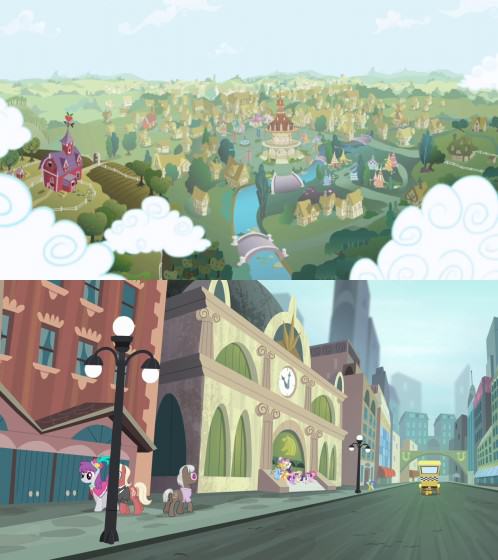
Nature figures prominently in the rural landscape of Ponyville, as the above image illustrates. Scenes always contain plants, trees, animals, and even flying insects. The soundscape often includes birds chirping. The pony’s houses are frequently populated by small animals, especially the Fluttershy’s home, where she lives with numerous animals that she cares for. In contrast to Ponyville, the setting of Manehattan leaves out street trees and the sounds of birds. The urban scenes are louder with more background noise, such as talking and cars. MLP takes nature out of the urban to make the contrast with the rural idyllic more drastic. The visuals of each landscape, however, are similar in terms of animation technique: bright colours, light, and soft images.
The ponies also interact differently with the urban and rural landscapes. In episodes set in Manehattan, ponies from Ponyville are often more tense, get frustrated easily, and long for the calm and quiet of the rural. The ponies also take on stereotypical urban characteristics, such as the example of Rarity above. When she participates in the fashion show, she becomes more competitive and treats her friends like workers. Back in Ponyville, the ponies’ main role is to make sure that nature is kept in balance—they each have a role to play in caring for and maintaining nature. Along with caring for friends, caring for nature is the key task in MLP.
Environment and aesthetics in Teenage Mutant Ninja Turtles
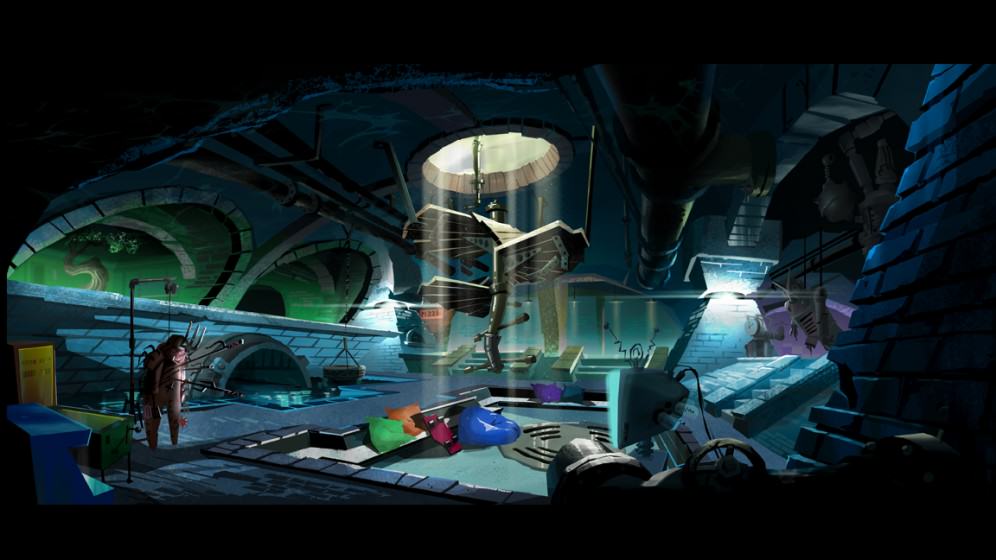
The world in Teenage Mutant Ninja Turtles (TMNT) is radically different from MLP. TMNT takes place in an urban landscape, yet like MLP’s Manehattan, it is also a fictitious New York City. The four teenage turtles and their father figure and sensei, Master Splinter, live below the city in the storm sewers. They only emerge onto the surface at night, as they are trained to be shadows and to hide from humans. Because the show takes place below the city and at night, the visuals are very dark; the shades used in the animation are gloomy, with only splashes of colour (figures above and below). The sewer lair is lit from above by what seems to be the subway system, and by dim lights placed near the walls. In the aboveground landscape of New York City, there are no street trees or plants visible. Nor are there any bird sounds, even on the rare occasions when the Ninja Turtles leave the sewers during the day. While there is no ‘green’ nature displayed in the above ground cityscape, neither are there any natures that run through the storm sewers; that is, it never seems to rain while the turtles are in their lair, even though they live in storm sewers.
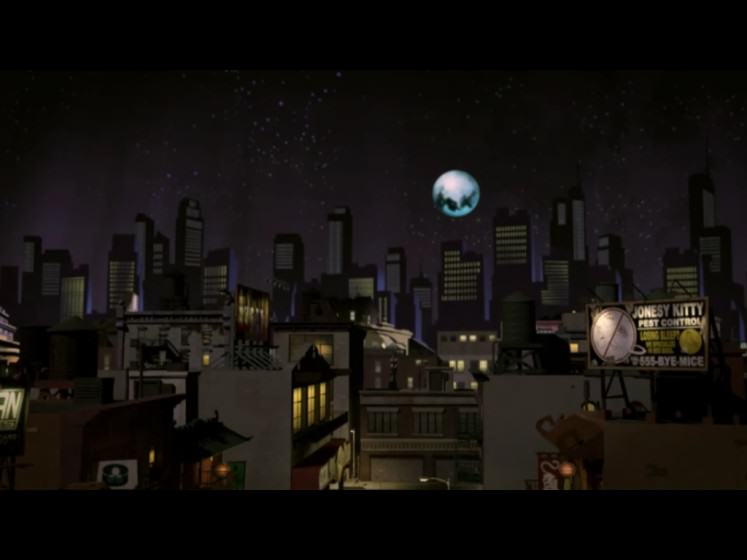
The visual and sound landscapes change dramatically when the Ninja Turtles and two friends need to leave New York City and drive to a farmhouse several hours away. Leaving the city in a VW van, the turtles go to recuperate and energise in the country. In the rural setting of the farm, the animation because much lighter and colourful (figure below). The setting here is, of course, full of nature; the farmhouse is surrounding by forest and the Ninja Turtles have to learn how to be in ‘Nature’, including interacting with animals such as chickens and deer. Indeed, Michelangelo becomes attached to the farm animals, tearing up when he has to say goodbye. In the rural landscape, the turtles fight different ‘bad guys,’ many if which draw on mythical tales. For example, Bigfoot appears in one episode.
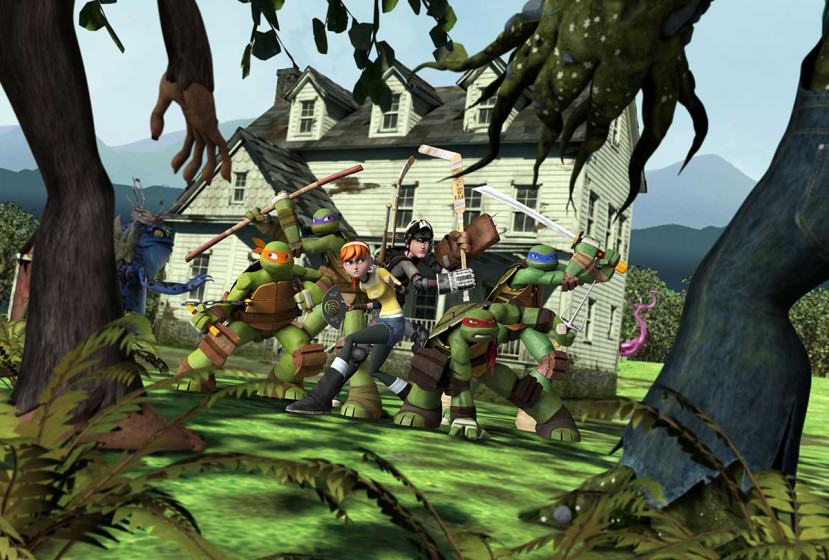
Experiencing nature at the farmhouse becomes pivotal in the Ninja Turtles’ journey to becoming better masters of Ninjitsu, which involves deeper concentration and balance. In this way, the idealisation of a balanced nature is directly linked to inner peace and focus within the turtles. This connection is clearly portrayed in season three, episode eight, when the turtles leave the farmhouse to camp in the forest. Their task is to practice Ninjitsu, to meditate, and to be at one with nature. After having a vision of Master Splinter, the turtles embark on individual journeys, each of which is linked to a goal and to an element of nature. Raphael is represented by fire and needs to find focus; Leonardo follows the wind to become an exemplary leader; Donatello has to find more power in the mountains; and Michelangelo is too distracted and needs to find calm in the forest/woods. At the end of their journeys, the turtles emerge from the forest triumphant, each bearing a banner with their newfound nature element and ready to return to New York City to fight the colonizing alien species, the Kraang (figure below). There are little emotional affinities towards protecting nature in TNMT. Rather, nature serves as a source of power and strength. It is rejuvenating and energising.
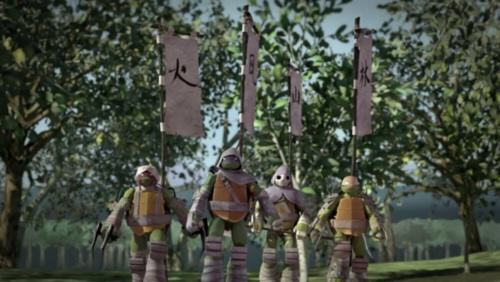
Affective atmospheres, media landscapes, children and nature
Both MLP and TNMT exemplify a dominant and romanticized understanding of nature: nature is outside cities and is ‘othered’. Moreover, nature is portrayed stereotypically as something important to protect and to dominate as well as an idealised escape from the urban, which is calming and energising. MLP—a show aimed at girls—very obviously generates feelings of care and protection for nature. It is a key element in the show. Indeed, nature in MLP is in a pastoral setting and is venerated. Nature is calming, healing, in balance, in need of protection, and outside of cities.
This is also the case in TNMT, but only in four episodes; the majority of episodes take place in a city devoid of nature. The feelings both shows produce about nature do nothing to challenge dominant understandings of nature for children. But the presence of nature in MLP makes it clear that girls should take care of nature while in TMNT, boys fight off imaginary bad guys in cities and go to the rural areas to rejuvenate in nature. Here we have the too-easy association of male-culture and female-nature; we might further map male-rational-urban, female-emotional-rural onto these stereotypes, It is difficult to extract the exact emotions these shows generate in children since each child interacts and interprets differently based on his or her experiences and geography (e.g. urban or rural). But these shows most certainly play a part in shaping understandings of nature (and spaces).
In the everyday lives of Chloe and Antoine, we can consider the TV shows they watch as affective atmospheres in their lives. The shows they watch affect their feelings, emotions, and understanding of nature. It is almost too simple to draw connections between the representations and feelings of nature (and the urban/rural divide) in both shows to the reactions of Chloe and Antoine to the “bird apartments.” However, pointing to the obvious similarities between the shows that Chloe and Antoine watched during this time and their respective reactions illustrates how media shapes our spatialised relations with nature. Chloe was very much attached to the figure of Fluttershy in MLP, and she loved Fluttershy’s house (figure below).
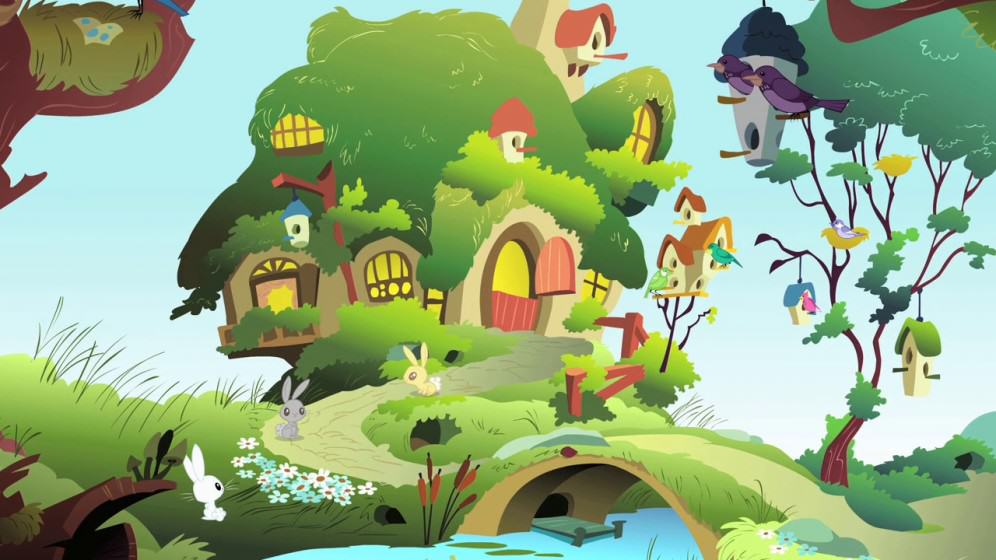
The bird apartment on Chloe’s house most likely reminded her of Fluttershy’s house, although Chloe did not express this verbally. For her, that her house was located in an urban setting did not matter; what was important was that the house was shared with animals. Just as Fluttershy’s home in MLP was always more-than-human (and not just because the main characters are ponies—they are, after all, anthropomorphized). Fluttershy’s home is inhabited by all sorts of creatures because it is in the rural forest and is part of creating balance. This is not, as I point out above, unproblematic. Chloe felt as though she need to take care of the birds and was curious how they could survive without someone (such as humans) to help them. Antoine, in contrast, felt little in common with the birds and other animals dwelling with him. For Antoine, the birds belonged in the country and not in the city. That his house was urban was an important element in whether the animals belonged because, in his favourite show, TNMT, urban New York does not have trees or animals.
It is difficult to imagine how these media landscapes—the affective atmospheres of children’s media—cannot influence how children feel about the material socio-natural spaces they inhabit. As Whitely notes, the feelings about nature that are created through animated films have very real material affects. Almost a century of Disney’s influence in shaping feelings and understandings of human-nature relations in N. America, Europe, and beyond cannot be underestimated. Analysing how media portrays nature and human-nature relations is necessary, but there also needs to be more focus on showing how ideas and emotions regarding nature in media transfer to everyday ways of interacting with nature.
Richard Louv’s ‘Children and Nature Movement’ and similar campaigns tend to eschew media as an evil technology; in many ways, they are justified given the ways in which nature is portrayed by the media. However, even for children who are exposed to few hours of media (such as my daughter, who is allowed to watch no more than 2 hours/week), media is powerful because these children interact with other children who are exposed to films and TV shows every day (and we cannot ignore the power of literature as well!). Yet while the ‘Children and Nature Movement’ and similar movements critique the ubiquity of media, they tend to recreate the same ideas that are generated by the media. Such movements seek to reconnect children to nature. The argument is that children are being distanced from their natural (innate) connection to nature, what Louv diagnoses as ‘nature deficit disorder’. While such movements have the potential to be very beneficial efforts for children, there is little critical reflection on how children’s relationship to nature is socially constructed as gendered, culturally specific, and spatially fixed (authentic nature is outside the city).
Scholars and others have pointed out the ways in which girls and boys interact with and play in nature differently, but few analyse such gendered play in nature as socially constructed. Movements to reconnect children seem not to be concerned with reproducing (problematic) gender stereotypes. They also tend to reinforce the spatial divide of urban-culture and rural-nature by privileging the natures outside of cities, such ‘wild’ natures, which are depicted as more therapeutic and authentic. By not recognizing gendered and spatial differences in children’s relation with nature, such movements implicitly naturalise gendered relations and fail to challenge the dominant and problematic understandings of nature. If we are to reshape children’s relations to and understandings of nature, then engaging with work in media on representations of nature and human-nature relations is critical—especially if we want to avoid reinforcing and perpetuating problematic, romantic, idealized human-nature relations.
What do we do to counteract media that reifies problematic human-nature relations? How do we create media and urban spaces that enable Chloe and Antoine to produce different notions about nature (or that emphasise nature’s diversity and dynamism) and open their minds to different notions about what it means to be a boy, a girl, or something else? My family has since relocated to Costa Rica, so Chloe and Antoine have not been able to revisit their dialogue about birds, squirrels, and gender. But Chloe has moved on from MLP to the Magic School Bus and Spongebob Squarepants, both of which are slightly less problematic. The Magic School Bus uses a scientific perspective to explore different natures (from the human body to insects to ocean ecosystems). And Spongebob Squarepants….well, I am still not sure how to anlayse this show. Perhaps, in some ways, Spongebob illustrates how a completely fantastical world that does not seek to imitate or teach reality opens up possibilities for thinking differently about nature-society relations.
Laura Shillington
San José
Notes
- This article is adapted and shortened from a forthcoming chapter entitled ‘Birds are for the girls: children’s media landscape and the emotional geographies of urban natures’ in Skelton, T., Dwyer, C., & Worth, N. (eds). Geographies of Children and Young People: Volume 4: Geographies of Identities and Subjectivities, Springer Reference.
- The names in the Chloe and Antoine story have been changed.
Works cited
Aitken, S. (2001) The Geographies of Young People: The Morally Contested Spaces of Identity. Routledge, New York and London.
Anderson, B. (2009) Affective Atmospheres, Emotion, Space and Society 2: 77–81.
Delano Robertson, V.L. (2014) Of ponies and men: My Little Pony: Friendship is Magic and the Brony fandom, International Journal of Cultural Studies, 17(1): 21-37.
Faust, L. (2010). My Little NON-Homophobic, NON-Racist, NON-Smart-Shaming Pony: A Rebuttal, Ms. Magazine Blog, 24 December. Online: http://msmagazine.com/blog/2010/12/24/my-little-non-homophobic-non-racist-non-smart-shaming-pony-a-rebuttal/
Holtzman, L., & Sharpe, L. (2014). Media messages: What film, television, and popular music teach us about race, class, gender, and sexual orientation. Second edition. New York: ME Sharpe.
James, A., C. Jenks, and A. Prout (1998) Theorizing Childhood. Polity Press, Cambridge.
Singer, G. & Singer, J.L. (2012). Handbook of children and the media. Second edition. Thousand Oaks, CA: Sage.
Taylor, A. (2013) Reconfiguring the Natures of Childhood. Routledge, New York.
Vossen, H., Piotrowski, J.T. & Valkenburg, P.M. (2014). Media use and effects in childhood. In Nussbaum, J.F. (Ed) The handbook of lifespan communication (pp. 93-112). New York: Peter Land Publishing.
Whitley, D. S. (2012). The idea of nature in Disney animation. Second edition. Surrey: Ashgate Publishing.


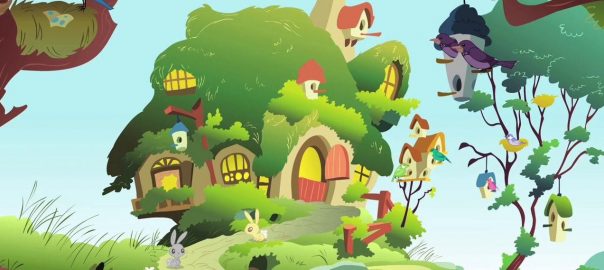

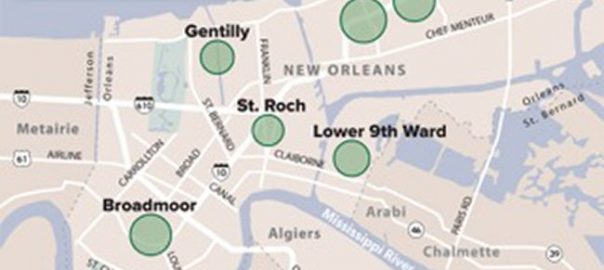
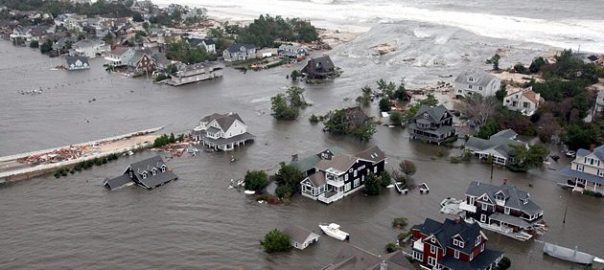
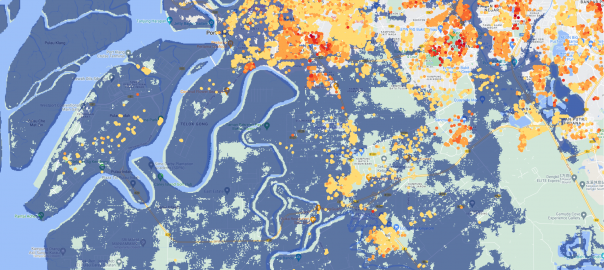
Leave a Reply